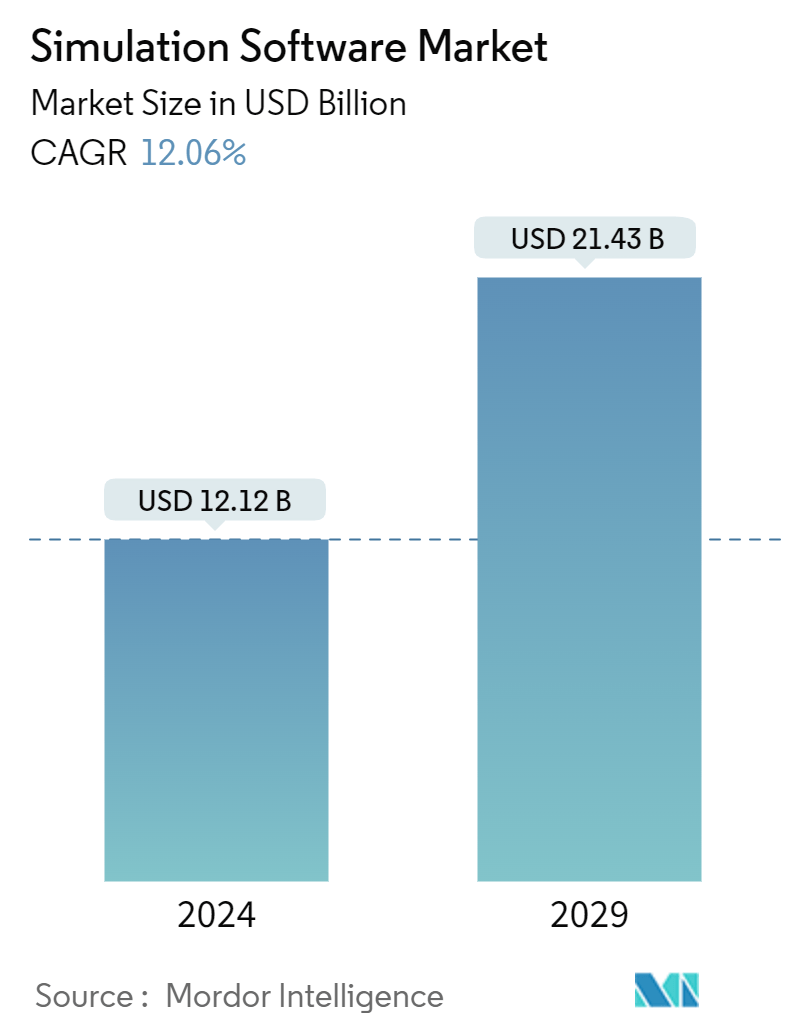Market Size of Simulation Software Industry

| Study Period | 2019 - 2029 |
| Market Size (2024) | USD 12.12 Billion |
| Market Size (2029) | USD 21.43 Billion |
| CAGR (2024 - 2029) | 12.06 % |
| Fastest Growing Market | Asia Pacific |
| Largest Market | North America |
Major Players
*Disclaimer: Major Players sorted in no particular order |
Simulation Software Market Analysis
The Simulation Software Market size is estimated at USD 12.12 billion in 2024, and is expected to reach USD 21.43 billion by 2029, growing at a CAGR of 12.06% during the forecast period (2024-2029).
Simulation software is integral to industries that depend on advanced design, testing, and modeling environments. This technology is widely utilized across key sectors such as automotive, aerospace, defense, energy, telecommunications, and education. The software enables users to create digital prototypes, simulate real-world applications, and test complex systems without the need for physical experimentation. This leads to cost reduction, increased efficiency, and faster innovation cycles.
- Key Drivers: Automotive Industry's Impact on Growth The automotive sector is a significant contributor to the expansion of the simulation software market. The rising demand for electric vehicles (EVs) and autonomous driving technologies necessitates sophisticated simulation tools to design, test, and refine complex vehicle systems. These tools are essential for developing and optimizing powertrains, battery systems, and in-vehicle infotainment technologies. Similarly, in the aerospace and defense industries, simulation software is critical for modeling high-risk environments, improving safety and performance in aircraft design, and enhancing defense systems and mission-critical operations. In the energy sector, simulation software is increasingly adopted to optimize renewable energy systems such as wind and solar power, mitigating variability and unpredictability.
- Cloud-Based Simulation Software: A Growing Trend The market for cloud-based simulation software has experienced notable growth. Cloud platforms offer scalability, flexibility, and cost advantages over traditional on-premise solutions. With cloud-based systems, users can access powerful simulation tools over the internet, fostering collaboration and reducing the need for significant upfront infrastructure investments. This trend aligns with the broader industry shift toward digital transformation. Cloud-based solutions also support artificial intelligence (AI) and machine learning (ML) integration, enabling more efficient simulations and optimized workflows.
Rising Demand from the Automotive Sector
- Increased Need for EV Simulation: The surge in electric vehicle (EV) development has amplified the need for advanced simulation tools. Automakers leverage simulation software to design and test EV components, such as battery systems and charging infrastructure. By simulating real-world performance, manufacturers can identify potential issues during the early stages of development, reducing costs and time-to-market.
- Simulation for Autonomous Driving Technologies: Autonomous vehicles require extensive testing under various conditions, which can be difficult to replicate in the real world. Simulation software allows for the virtual testing of autonomous driving systems across multiple road and weather conditions, ensuring their safe operation in complex environments. Major automakers and technology firms have embraced these tools to accelerate the development of autonomous vehicles.
- Digital Twins Enhance Vehicle Development: Digital twins—virtual replicas of physical products—are increasingly used in automotive simulation to model in-vehicle technologies, from infotainment systems to safety features. By using digital twins, automakers can simulate performance under diverse conditions, improving user experience and vehicle safety.
The Growing Shift to Cloud-Based Simulation Solutions
- Flexibility and Scalability of Cloud Platforms: Cloud-based simulation software is gaining traction due to its inherent flexibility and scalability. These solutions allow companies of all sizes to access advanced simulation tools without heavy infrastructure investments. Cloud platforms support global collaboration, enabling engineers and designers to access and analyze simulation data in real-time.
- Cost-Effectiveness for SMEs: The subscription model of cloud-based simulation solutions reduces capital expenditure, making advanced tools accessible to small and medium enterprises (SMEs). This scalability allows users to adjust computational resources according to project needs, enhancing cost efficiency.
- AI and Machine Learning Integration: AI-driven simulation workflows can optimize design processes by running multiple scenarios in parallel, identifying the most efficient configurations. This capability is particularly valuable in manufacturing, where even minor gains in efficiency can result in significant cost savings.
Simulation Software Industry Segmentation
Simulation is the imitation of the operation of a real-world process or system. The act of simulating something first requires a mathematical model to be developed. This replicated model represents the key characteristics of the physical process. The model basically represents the system itself, whereas the simulation software runs the operation of the system over time.
The simulation software market is segmented by deployment (on-premise, cloud), end-user industry (automotive, IT and telecommunication, aerospace and defense, energy and mining, education and research), and geography (North America, Europe, Asia Pacific, Latin America, and Middle East and Africa).
The market sizes and forecasts are provided in terms of value (USD) for all the above segments.
| Deployment Type | |
| On-premise | |
| Cloud |
| End-user Industry | |
| Automotive | |
| IT and Telecommunication | |
| Aerospace and Defense | |
| Energy and Mining | |
| Education and Research | |
| Electrical and Electronics | |
| Other End-user Industries |
| Geography | |
| North America | |
| Europe | |
| Asia | |
| Australia and New Zealand | |
| Latin America | |
| Middle East and Africa |
Simulation Software Market Size Summary
The simulation software market is experiencing significant growth, driven by its evolving applications beyond traditional production line adjustments. Initially focused on optimizing manufacturing processes, simulation software now plays a crucial role in testing new concepts, accelerating product development, and ensuring regulatory compliance. This shift is largely due to the high costs associated with production downtime and the need for manufacturers to maintain operational efficiency and reputation. The software's ability to preemptively identify and resolve issues, simulate component interactions, and demonstrate compliance has led to its increased adoption across various industries. Notable use cases include Siemens modeling Electrolux's factories for operational efficiencies and Dassault Systèmes assisting Global Trailers in streamlining trailer market entry processes. The education and research sectors also contribute to market expansion, as real-time simulation scenarios offer cost-effective and time-efficient solutions, enhancing core business competencies.
In the automotive industry, the demand for simulation software is fueled by the shift towards autonomous and electric vehicles, necessitating advanced manufacturing techniques and intricate designs. High-performance computer simulation tools are now integral to optimizing product development and manufacturing processes, helping manufacturers avoid costly inefficiencies. Companies like BMW are investing in extensive simulation facilities to enhance their expertise in autonomous driving technologies. The North American market is poised for substantial growth, supported by a surge in SME units and a focus on research and development. Government initiatives promoting eco-friendly practices and innovative city projects further drive the adoption of simulation technology. The competitive landscape features major players like Ansys, Siemens AG, and Autodesk Inc., who are engaging in strategic partnerships and product innovations to maintain market leadership.
Simulation Software Market Size - Table of Contents
-
1. MARKET DYNAMICS
-
1.1 Market Overview
-
1.2 Industry Attractiveness - Porter's Five Forces Analysis
-
1.2.1 Threat of New Entrants
-
1.2.2 Bargaining Power of Buyers/Consumers
-
1.2.3 Bargaining Power of Suppliers
-
1.2.4 Threat of Substitute Products
-
1.2.5 Intensity of Competitive Rivalry
-
-
1.3 Impact of the COVID-19 on the Market
-
1.4 Market Drivers
-
1.4.1 Rising Demand from the Automotive Sector
-
1.4.2 The Growing Shift to Cloud-Based Simulation Solutions
-
-
1.5 Market Restraints
-
-
2. MARKET SEGMENTATION
-
2.1 Deployment Type
-
2.1.1 On-premise
-
2.1.2 Cloud
-
-
2.2 End-user Industry
-
2.2.1 Automotive
-
2.2.2 IT and Telecommunication
-
2.2.3 Aerospace and Defense
-
2.2.4 Energy and Mining
-
2.2.5 Education and Research
-
2.2.6 Electrical and Electronics
-
2.2.7 Other End-user Industries
-
-
2.3 Geography
-
2.3.1 North America
-
2.3.2 Europe
-
2.3.3 Asia
-
2.3.4 Australia and New Zealand
-
2.3.5 Latin America
-
2.3.6 Middle East and Africa
-
-
Simulation Software Market Size FAQs
How big is the Simulation Software Market?
The Simulation Software Market size is expected to reach USD 12.12 billion in 2024 and grow at a CAGR of 12.06% to reach USD 21.43 billion by 2029.
What is the current Simulation Software Market size?
In 2024, the Simulation Software Market size is expected to reach USD 12.12 billion.

